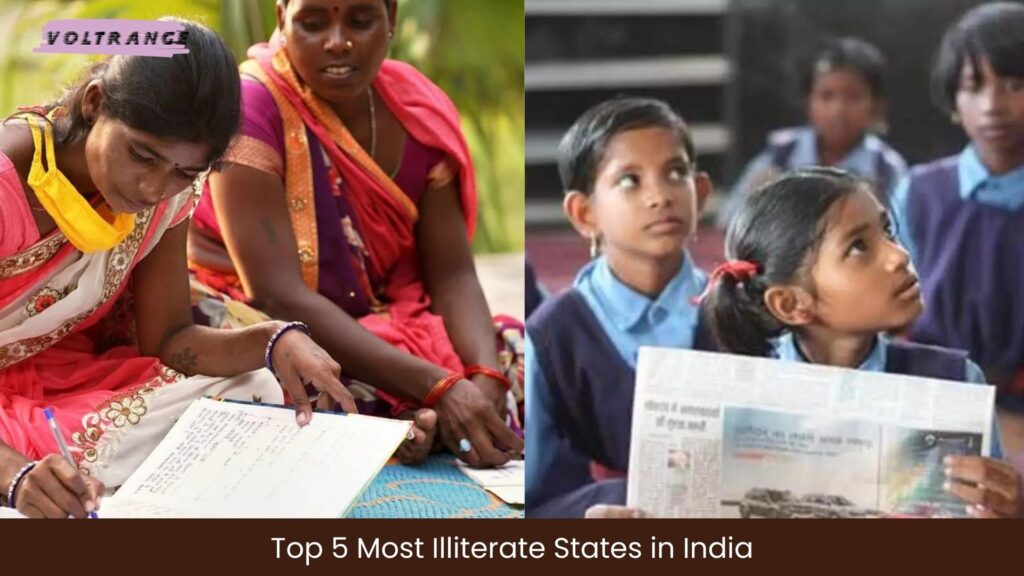
Top 5 Most Illiterate States in India
Most Illiterate States in India: India has seen remarkable growth over the past few years, especially in the education sector, which is undeniably one of the key factors for the nation’s development. Through initiatives like Digital India, Sarva Shiksha Abhiyan, and efforts to make education more inclusive, the country has worked to enhance literacy rates across its vast regions. However, despite these substantial efforts, some states are still grappling with literacy challenges. A closer look at these states highlights the importance of continued efforts to improve access to education, address gender gaps, and implement effective reforms.
In this article, we will examine the five least literate states in India as of 2024, highlighting their current literacy rates, the disparities between male and female literacy, and the key challenges these regions face. Let’s explore the states that need the most attention in terms of education and how they can overcome these obstacles for a brighter future. Most Illiterate States in India
1. Andhra Pradesh – 66.4% Literacy Rate
Andhra Pradesh currently ranks as the state with the lowest literacy rate in India, standing at just 66.4%. Situated in the southern coastal region, Andhra Pradesh is rich in culture, agriculture, and industry, but it struggles when it comes to education. This glaring statistic highlights the pressing need for reforms within the state’s educational system.
The literacy gap between men and women is quite significant in Andhra Pradesh, with male literacy at 73.4% compared to female literacy at 59.5%. This gender disparity reflects a broader issue within the state’s rural areas, where educational access for girls remains limited due to socio-cultural norms, lack of resources, and infrastructural challenges. Most Illiterate States in India
The state government has implemented various initiatives to uplift the literacy rate, but these efforts need to be expanded further. Programs focused on vocational training, digital literacy, and increasing school enrollment in rural areas could significantly boost literacy levels and bridge the gender divide.
2. Rajasthan – 69.7% Literacy Rate
With a literacy rate of 69.7%, Rajasthan is another state where education is lagging, despite its rich history and cultural heritage. The disparity between male and female literacy in Rajasthan is stark: 80.8% for men and just 57.6% for women. This clear-cut gender gap stems from long-standing cultural norms that prioritize male education over female education in many parts of the state. Most Illiterate States in India
The sheer size of Rajasthan, coupled with its large population of over 68 million, creates logistical challenges when it comes to delivering quality education to remote areas. However, the state government has been working to close these gaps through initiatives such as the Rajasthan Education Initiative and programs aimed at increasing female enrollment in schools.
Improving access to education for women and girls, particularly in rural and desert areas, is critical for Rajasthan’s educational progress. Adult literacy programs and efforts to create a more inclusive school environment will be vital in improving the overall literacy rate in the coming years.
3. Bihar – 70.9% Literacy Rate
Once a center of learning during ancient times, Bihar now faces significant challenges in the realm of education. With a literacy rate of 70.9%, it ranks as the third least literate state in India. While this figure shows some improvement from previous years, there is still much work to be done. Most Illiterate States in India
Male literacy in Bihar stands at 79.7%, while female literacy lags behind at 60.6%. This gender divide underscores the deep-rooted societal challenges that continue to affect female education in the state. Nevertheless, Bihar has made considerable strides over the past decade, with efforts focused on strengthening its educational infrastructure, training teachers, and promoting gender equality in schools.
Bihar’s government is working to overcome its educational challenges through programs like Mukhyamantri Balika Cycle Yojana, which incentivizes girls to stay in school, and various digital education initiatives. Continuing to address gender inequality and improving rural education access are crucial for the state’s future literacy growth.
4. Telangana – 72.8% Literacy Rate
Telangana, India’s newest state formed in 2014, has a literacy rate of 72.8%. While it has made substantial progress since its inception, the state still faces educational challenges, particularly in rural areas. The literacy rate for men is 80.5%, while for women it is 64.4%, indicating a significant gender gap that mirrors the challenges seen in other parts of the country. Most Illiterate States in India
Telangana’s government has placed a strong emphasis on improving its educational system, especially by integrating technology into classrooms. Programs like DigiTelangana and digital literacy campaigns aim to bridge the gap between rural and urban education, providing students in remote areas access to online learning tools and resources.
Despite these efforts, more needs to be done to ensure equitable access to quality education for all children, particularly girls and marginalized communities. The state must continue to focus on increasing school enrollment and retention rates to raise its overall literacy levels.
5. Uttar Pradesh – 73% Literacy Rate
Uttar Pradesh, the most populous state in India with over 241 million residents, has a literacy rate of 73%. While the state has made significant progress in improving its education system, it still faces considerable challenges due to its vast population and diverse socio-economic conditions. Most Illiterate States in India
Male literacy in Uttar Pradesh stands at 81.8%, while female literacy is 63.4%, indicating a gender gap that the state is actively trying to close. The government has implemented a variety of programs aimed at improving the quality of education, including initiatives to train teachers, modernize school infrastructure, and promote adult literacy.
Given the state’s size and population, ensuring that educational reforms reach every corner of Uttar Pradesh is a monumental task. However, with continued investment in education, particularly in rural areas, the state is poised to make further strides in improving its literacy rate.
Key Challenges Facing India’s Least Literate States
Although each of these states faces unique challenges, there are several common factors contributing to their low literacy rates: Most Illiterate States in India
- Gender Disparity: In almost all of these states, there is a significant gap between male and female literacy, with women facing more barriers to education due to cultural, social, and economic reasons.
- Rural Access: Many of the least literate states have large rural populations, where access to quality education is limited due to poor infrastructure, lack of trained teachers, and inadequate resources.
- Socio-Economic Factors: Poverty remains a significant obstacle, as many families in these states prioritize immediate economic needs over long-term educational goals.
- Inadequate Infrastructure: Schools in rural areas often suffer from a lack of basic facilities, such as clean drinking water, electricity, and proper classrooms, further hindering educational progress.
FAQs about Illiterate States in India
What are the main reasons behind low literacy rates in some states of India?
The primary reasons include gender disparity, rural inaccessibility, socio-economic barriers, and inadequate educational infrastructure. Cultural norms also play a role in restricting access to education for certain groups, particularly women and girls.
Which state has the lowest literacy rate in India in 2024?
As of 2024, Andhra Pradesh has the lowest literacy rate in India, with only 66.4% of its population being literate.
What steps are being taken to improve female literacy in these states?
States like Bihar and Rajasthan have implemented programs to promote female education, such as providing scholarships, bicycles for commuting, and building separate toilets for girls in schools to encourage attendance.
How does digital education impact literacy rates in India?
Digital education initiatives, especially in states like Telangana, are playing a critical role in bridging the urban-rural education divide. Online learning tools, digital classrooms, and internet access can help improve literacy, especially in remote areas.
What can be done to further improve literacy rates in India?
Improving literacy rates in India requires addressing gender disparities, investing in rural education infrastructure, promoting adult literacy programs, and creating an inclusive, supportive environment for all learners.





More Stories
which of the following statements is true about education and lifetime earnings? Complete Guide Here
Statekaidz.com: Education with Fun For Kids 2025
Top 5 Richest States in India by GDP